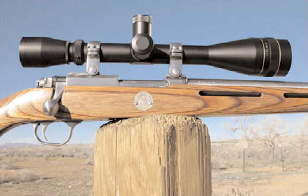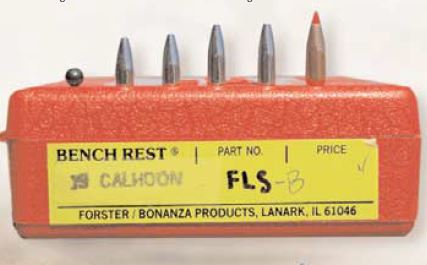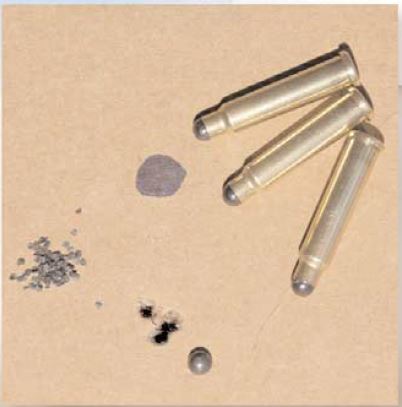
Based on an improved Hornet case, the .19 Calhoon is a varmint cartridge that performs far out of proportion to its size. Burning less than 15 grains of powder, extended shooting with a 27 grain bullet at 3,600 fps, is more fun than you can imagine.
Varmint hunting is very popular with shooters for several reasons. A good big game season might see you get the chance to fire one or two shots at most, or perhaps a half-dozen if you hunt several species. Near where I live in New Mexico, on a good afternoon, I can easily fire several hundred shots after work, before it gets too dark to see. The target of opportunity is the prairie dog, literally thousands and thousands of them within about one-half hour drive from home.
Prairie dogs are burrowing rodents, about the size of a squirrel, but without the long bushy tail. They are viewed as a “nuisance” animal, as in large numbers they consume vast quantities of grass and crops. They also leave an area full of 3 to 6 inch holes, which can result in livestock breaking a leg. Farmers and ranchers are only too happy to have shooters come in to work a field over hard, with precision small-bore rifles.
Originally in the area where I hunt, only rimfires were allowed. For the first time, this year they are allowing centerfire rifles with fast-expanding frangible bullets. The .22 LR worked all right out to 50 yards or so, and the .22 Magnum- or the .17 Hornady Magnum Rimfire (HMR)- could push the range to 100 plus yards. As a long shot might be 150 yards, there was no need to go to a .223 Remington, let alone the .22-250. The .22 Hornet was a possibility, but the relatively low velocities of the 45-gr bullets make them more prone to ricochets. What is a shooter to do?
Chapter 1: Enter the .19 Calhoon
Click for LOAD DATA SHEET
Simply stated, the .19 Calhoon is a far superior use of the Hornet case. Take a new Hornet case, neck it down to accept a .198 diameter bullet, and then blow it out to an “improved” format. Remington brass works best, but Winchester can also be used. Calhoon also sells pre-formed brass, for not much more than Hornet cases cost. Reloading the .19 Calhoon costs about half that of buying .17 HMR ammo, but it easily gives you twice the...
energy and range of the .17.
It gives an honest 3,600 fps with a 27-gr bullet, while burning less than 15 grains of powder. Its modest appetite for powder is a big plus. This helps to keep the barrel from
getting too hot, when hundreds of rounds are shot in just a few hours. In varmint hunting, speed is king. I can promise you that the 27-gr bullets are very “humane” when it comes to harvesting a prairie dog. In fact, it was quite difficult to take a dog that left enough to allow for a good photograph.
Chapter 2: Why the .19 caliber? James Calhoon Mfg.

James Calhoon Mfg. is located in north central Montana. James originally became interested in the .19 caliber, when reading about NATO field trials in the 1970’s for a
superior infantry round. Of all of the calibers tested (14, 17, 19, 20, 22, 27 and 30) the 4.85 mm experimental round, or the .19, was the winner. The reason for going with the
.22 caliber, was the military’s preference for the thickness of the cleaning rod for that caliber. A benefit of the .19 caliber for shooters is that the rifling thickness is 50 to 100
% greater with the .19, than the .17 caliber.
great 2-lb trigger, a free-floated Pac-Nor Super Match barrel in varmint contour
Originally Calhoon only offered re-barrel kits for the .19 that your gunsmith can install. Now they also sell completed rifles in the .19 Calhoon. You have a choice of a converted Ruger 77-22 Hornet using a modified factory six-shot detachable rotary magazine, or a CZ 527 with a 5-shot detachable box magazine. I went with the Ruger rifle for these tests.
It comes from Calhoon with a great 2-lb trigger, a free-floated Pac-Nor Super Match barrel in varmint contour (24” with a muzzle diameter of .650“). You can also get a 23”
sporter contour measuring .550” at the muzzle. The barrel is free-floated, and the stock is ventilated, for better accuracy and cooling. James also puts his own distinctive metal emblem into the right side of the stock. Ruger stainless rings come with the gun. I chose to top it with an excellent...
Leupold VX-II, 6-18x40mm AO target, with a fine duplex reticle. The scope allowed me to clearly see my hits at 150 plus yards. All around, this is an excellent varminting rig.
Chapter 3: Care and Feeding

Remington cases were used exclusively for all loads, as were CCI 400 small rifle primers. The maximum case length is 1.400”, with a trim-to of 1.390”. All cases were FL sized using the Bonanza Benchrest set that came with the gun. A neck-sizing die is also available. All bullets were seated to 1.775” overall length. Calhoon sells a complete line of accessories to support the .19, including cleaning rods and brushes, patches, and a bore guide. Take a .17 caliber plastic funnel, open the hole up with a 3/16” drill, and you are ready to load, or get a .20 caliber funnel.
Accurate 1680 ball powder was used for the full power loads. It meters very consistently, and provided good accuracy and velocities. Several other powders are suitable for the .19 Calhoon. See the attached chart for my tested loads, and others as recommended by Calhoon. All loads shot between 0.58 and 0.80” at 100 yards. The special coating of the Calhoon bullets is said to maintain accuracy without cleaning, for up to 150 shots. Just what the varmint doctor ordered.
Calhoon also recommended a great shooting mid-range load. It duplicates the velocity of the .223 Remington, but uses the 27-gr bullet. On smaller varmints, they will never know that the bullet that sent them spinning did not weigh 55 grains. Loading up with 8.0-grs of Blue Dot powder, gave 3,166 fps in this rifle. It was only tested at 50 yards, but the load consistently shot into just over 1/4″. Tripling the distance would still keep it on a varmint. While using about one-third the charge that the .223 requires, your barrel would take a lot of shooting to even get warm. As you review the above section on special use loads, the reason for reloading is very clear. You can have a lot more gun, and a lot more fun with reloads.
...
Chapter 4: Hunting with the .19

Let’s not beat around the bush. The 27-gr Calhoon bullet at 3,600 fps is extremely humane at dispatching small varmints. Take a look at the aluminum beverage can that was filled with water and shot. Notice how the bottom of the can took on the impression of the ground it was sitting on. That is what hydrostatic shock and frangible bullets are all about. Also note that if varmints take to wearing amour plate, the Calhoon can still get the job done. Did you notice the .28 caliber hole in the 1/8-inch mild steel plate?
Calhoon recommends the 27-gr bullet as a “single dog” projectile due to its extreme frangibility. Going to the 32 or 36-gr slugs will allow for “doubles” and even “triples” when dogs are clustered on a mound. This early in the season, the dogs are pretty much loaners- one here and there- so I was more than pleased with the rapid expansion of the 27s. In the winter, the heavier bullets would be great for coyotes and foxes. Though up close, the quick expansion of the 27-gr bullets would reduce the chance of damage to the far side of the pelt.
If you like small bores, and tinkering with different bullet weights and loads, then the accuracy of the .19 Calhoon would surely keep you entertained for quite a while. It is very exciting to shoot an accurate rifle that transfers lots of powder to the target, without getting beat up in the process. I can promise you that also getting to see the result through your scope… is an added bonus you will never tire of.